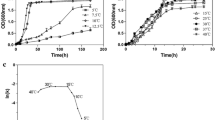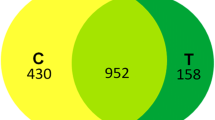Summary
A psychrotrophic bacterium Colwellia sp. NJ341 from Antarctic sea ice could grow at −5 and 22 °C, and the extent of cellular protein content and growth were greater at low temperatures (0–10 °C) than at higher temperatures. SDS-PAGE analysis demonstrated the presence of a 7 kDa cold-shock protein. The further result of two-dimensional electrophoresis (2-DE) showed that two proteins a and c were newly synthesized at near-freezing temperatures. With matrix-assisted laser desorption/ionization mass spectrometry (MALDI-TOF MS) analysis, proteins a and c were identified as glutathione S-transferase (GST) and cold-shock protein A (CspA), respectively, which were involved in cold-adaptation at near-freezing temperature in an Antarctic psychrophilic bacterium Colwellia sp. NJ341.
Similar content being viewed by others
References
Berger F., Morellet N., Menu F., Potier P., 1996 Cold shock and cold acclimation proteins in the psychrotrophic bacterium Arthrobacter globiformis SI55 Journal of Bacteriology 178:2999–3007
Chattopadhyay M.A., Jagannadham M.V., 2001 Maintenance of membrane fluidity in Antarctic bacteria Polar Biology 24: 386–388
Chintalapati S., Kiran M.D., Shivaji S., 2004 Role of membrane lipid fatty acids in cold adaptation Cellular and Molecular Biology 50: 631–642
Ermolenkoa D.N., Makhatadzea G.I., 2002 Bacterial cold-shock proteins Cellular and Molecular Life Sciences 59: 1902–1913
Feller G., Gerday C., 2003 Psychrophilic enzymes: hot topics in cold adaptation Nature Reviews Microbiology 1: 200–208
Graumann P.L., Marahiel M.A., 1998 A superfamily of proteins that contain the cold-shock domain Trends in Biochemical Sciences 23: 286–290
Graumann P.L, Schroder K., Schmid R., Marahiel M.A., 1996 Cold shock stress-induced proteins in Bacillus subtilis Journal of Bacteriology 178: 4611–4619
Hebraud M., Dubois E., Potier P., Labadie J., 1994 Effect of growth temperatures on the protein levels in a psychrotrophic bacterium, Pseudomonas fragi Journal of Bacteriology 176: 4017–4024
Hebraud M., Potier P., 1999 Cold shock response and low temperature adaptation in psychrotrohic bacteria Journal Molecular Microbiology and Biotechnology 1: 211–219
Huston A.L., Krieger-Brockett B.B., Deming J.W., 2000 Remarkably low temperature optima for extracellular enzyme activity from Arctic bacteria and sea ice Environmental Microbiology 4: 383–388
Janda T., Szalai G., Rios-Gonzalez K., Veisz O., Páldi E., 2003 Comparative study of frost tolerance and antioxidant activity in Cereals Plant Science 164: 301–306
Julseth C.R., & Inniss W.E., 1990 Induction of protein synthesis in response to cold shock in the psychrotrophic yeast Trichosporon pullulans Canadian Journal of Microbiology 36: 519–524
Kocsy G., vob Ballmoos P., Suter M, Rüegsegger A., Galli U., Szalai G., Galiba G., Brunold C., 2000 Inhibition of glutathione synthesis reduces chilling tolerance in maize Planta 211: 528–536
Mihoub F., Mistou M.Y., Guillot A., Leveau J.Y., Boubetra A., Billaux F., 2003 Cold adaptation of Escherichia coli: microbiological and proteomic approaches International Journal of Food Microbiology 89: 171– 184
Neuhaus K., Rappsch S., Francis K.P., Scherer S., 2000 Restart of exponential growth of cold-shocked Yersinia enterocolitica occurs after down-regulation of cspA1/A2 mRNA Journal of Bacteriology 182: 3285–3288
O’Farrell P.H., 1975 High resolution two-dimensional electrophoresis of proteins Journal of Biological Chemistry 250: 4007–4021
Penninckx M.J., Elskens M.T., 1993 Metabolism and functions of glutathione in microorganisms Advances in Microbial Physiology 34: 239 –301
Suzuki Y., Haruki M., Takano K., Morikawa M., Kanaya S., 2004 Possible involvement of an FKBP family member protein from a psychrotrophic bacterium Shewanella sp. SIB1 in cold-adaptation European Journal of Biochemistry 271: 1372–1381
Weber M.H., Marahiel M.A., 2003 Bacterial cold shock responses Science Progress 86: 9–75
Yamanaka K., Fang L., Inouye M., 1998 The CspA family in Escherichia coli: multiple gene duplication for stress adaptation Molecular Microbiology 27: 247–255
Acknowledgements
We gratefully acknowledge the contribution of Dr Xiao-Hang Huang for help with the manuscript. This study was supported by Program of National Natural Science Foundation of China. (No. 40406003)
Author information
Authors and Affiliations
Corresponding author
Rights and permissions
About this article
Cite this article
Wang, QF., Miao, JL., Hou, YH. et al. Expression of CspA and GST by an Antarctic psychrophilic bacterium Colwellia sp. NJ341 at near-freezing temperature. World J Microbiol Biotechnol 22, 311–316 (2006). https://doi.org/10.1007/s11274-005-9010-7
Received:
Accepted:
Published:
Issue Date:
DOI: https://doi.org/10.1007/s11274-005-9010-7




